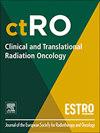Combining radiological and radiation oncology expertise in the delineation of hypopharyngeal tumours: potential effects on treatment volumes and patterns of failure
IF 2.7
3区 医学
Q3 ONCOLOGY
引用次数: 0
Abstract
Background and purpose
Target definition is one of the greatest uncertainties in the radiotherapy process. We aimed to investigate whether a radiologist specialized in head and neck can improve the target definition of hypopharyngeal cancers.
Materials and methods
We retrospectively identified 54 patients with hypopharyngeal cancer who received curative-intent radiotherapy between 2009–2015. New target structures were defined incorporating head and neck radiology expertise and updated delineation guidelines. The new structures were subsequently compared both quantitively and qualitatively to the original delineations. Loco-regional failures were analyzed in relation to radiotherapy dose and target volumes.
Results
There was a significant reduction in gross tumour volume (GTV) for the primary tumour, decreasing from 14.4 to 9.2 cm3 (−47 %), and in clinical target volume (CTV), decreasing from 203.7 to 93.8 cm3 (−54 %). Mean quantitative values indicated a large overestimation of the original GTV (Dice Coefficient 0.58 ± 0.2 SD, Jaccard index 0.44 ± 0.19 SD, Positive predictive value 0.53 ± 0.24 SD). Only 39 % of the original primary tumour GTV and 19 % of the original lymph node GTV were assessed as acceptable. Twelve patients (22 %) had a locoregional recurrence. In relation to both the original radiation dose and the updated dose distribution, nine recurrences were classified as in field, two as marginal, and one could not be evaluated. The 3-year and 5-year locoregional progression free survival (PFS) was 75.5 % and 66.6 % respectively.
Conclusion
Incorporating radiological expertise in the delineation of hypopharyngeal tumours leads to large changes in tumour volumes and possibly a decrease in radiation volumes which may lead to reduced side effects.
结合放射学和放射肿瘤学专业知识描述下咽肿瘤:对治疗量和失败模式的潜在影响
背景与目的靶区定义是放疗过程中最大的不确定性之一。我们的目的是调查一个专门从事头颈部的放射科医生是否可以改善下咽癌的目标定义。材料和方法回顾性分析2009-2015年间接受治疗意图放疗的54例下咽癌患者。结合头颈部放射学专业知识和更新的划定指南,定义了新的目标结构。新的结构随后被定量和定性地与原来的描绘进行比较。局部区域失败分析与放疗剂量和靶体积的关系。结果原发性肿瘤的总肿瘤体积(GTV)从14.4 cm3下降到9.2 cm3(- 47%),临床靶体积(CTV)从203.7 cm3下降到93.8 cm3(- 54%)。平均定量值显示对原始GTV有较大高估(Dice系数0.58±0.2 SD, Jaccard指数0.44±0.19 SD, Positive预测值0.53±0.24 SD)。只有39%的原发肿瘤GTV和19%的原发淋巴结GTV被评估为可接受的。12例(22%)有局部复发。与原始辐射剂量和更新后的剂量分布相比,9次复发归为现场,2次为边缘,1次无法评价。3年和5年局部无进展生存率(PFS)分别为75.5%和66.6%。结论将放射学知识纳入下咽肿瘤的划定,可使肿瘤体积发生较大变化,并可能减少放射量,从而减少副作用。
本文章由计算机程序翻译,如有差异,请以英文原文为准。
求助全文
约1分钟内获得全文
求助全文
来源期刊

Clinical and Translational Radiation Oncology
Medicine-Radiology, Nuclear Medicine and Imaging
CiteScore
5.30
自引率
3.20%
发文量
114
审稿时长
40 days
 求助内容:
求助内容: 应助结果提醒方式:
应助结果提醒方式:


